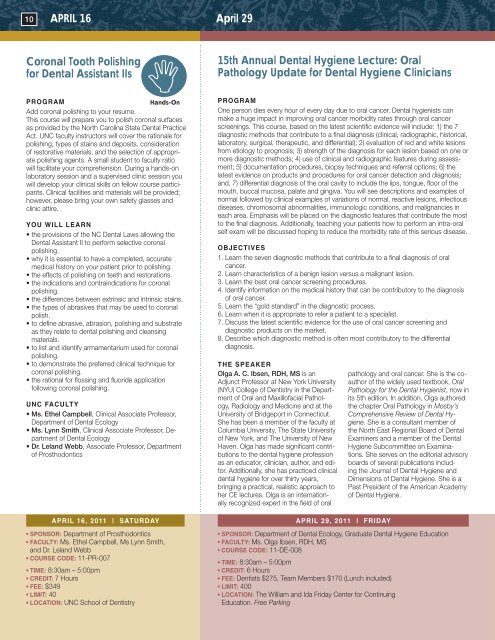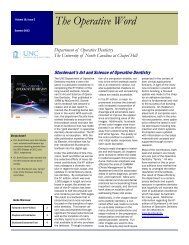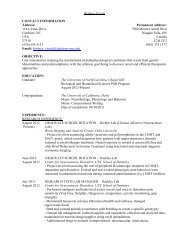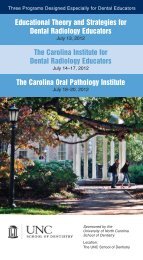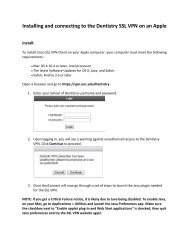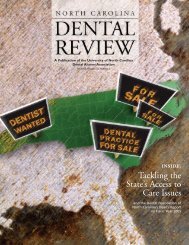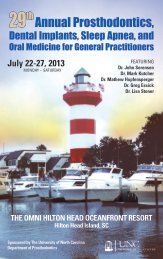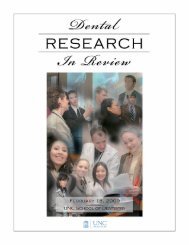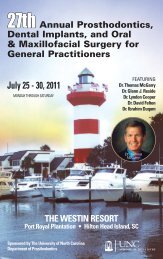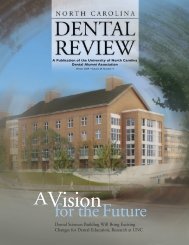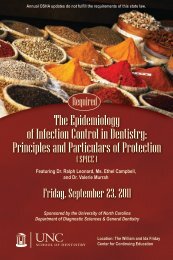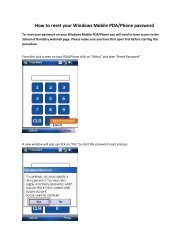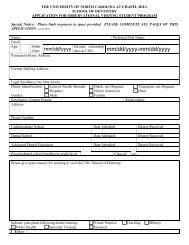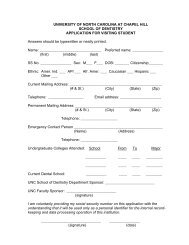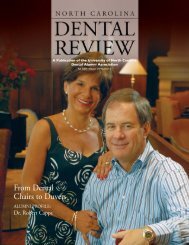CONTINUING DENTAL EDUCATION - UNC School of Dentistry ...
CONTINUING DENTAL EDUCATION - UNC School of Dentistry ...
CONTINUING DENTAL EDUCATION - UNC School of Dentistry ...
You also want an ePaper? Increase the reach of your titles
YUMPU automatically turns print PDFs into web optimized ePapers that Google loves.
10<br />
APRIL 16 April 29<br />
Coronal Tooth Polishing<br />
for Dental Assistant IIs<br />
15th Annual Dental Hygiene Lecture: Oral<br />
Pathology Update for Dental Hygiene Clinicians<br />
PROGRAM<br />
Hands-On<br />
Add coronal polishing to your resume.<br />
This course will prepare you to polish coronal surfaces<br />
as provided by the North Carolina State Dental Practice<br />
Act. <strong>UNC</strong> faculty instructors will cover the rationale for<br />
polishing, types <strong>of</strong> stains and deposits, consideration<br />
<strong>of</strong> restorative materials, and the selection <strong>of</strong> appropriate<br />
polishing agents. A small student to faculty ratio<br />
will facilitate your comprehension. During a hands-on<br />
laboratory session and a supervised clinic session you<br />
will develop your clinical skills on fellow course participants.<br />
Clinical facilities and materials will be provided;<br />
however, please bring your own safety glasses and<br />
clinic attire.<br />
YOU WILL LEARN<br />
• the provisions <strong>of</strong> the NC Dental Laws allowing the<br />
Dental Assistant II to perform selective coronal<br />
polishing.<br />
• why it is essential to have a completed, accurate<br />
medical history on your patient prior to polishing.<br />
• the effects <strong>of</strong> polishing on teeth and restorations.<br />
• the indications and contraindications for coronal<br />
polishing.<br />
• the differences between extrinsic and intrinsic stains.<br />
• the types <strong>of</strong> abrasives that may be used to coronal<br />
polish.<br />
• to defi ne abrasive, abrasion, polishing and substrate<br />
as they relate to dental polishing and cleansing<br />
materials.<br />
• to list and identify armamentarium used for coronal<br />
polishing.<br />
• to demonstrate the preferred clinical technique for<br />
coronal polishing.<br />
• the rational for fl ossing and fl uoride application<br />
following coronal polishing.<br />
<strong>UNC</strong> FACULTY<br />
• Ms. Ethel Campbell, Clinical Associate Pr<strong>of</strong>essor,<br />
Department <strong>of</strong> Dental Ecology<br />
• Ms. Lynn Smith, Clinical Associate Pr<strong>of</strong>essor, Department<br />
<strong>of</strong> Dental Ecology<br />
• Dr. Leland Webb, Associate Pr<strong>of</strong>essor, Department<br />
<strong>of</strong> Prosthodontics<br />
APRIL 16, 2011 | SATURDAY<br />
• SPONSOR: Department <strong>of</strong> Prosthodontics<br />
• FACULTY: Ms. Ethel Campbell, Ms Lynn Smith,<br />
and Dr. Leland Webb<br />
• COURSE CODE: 11-PR-007<br />
• TIME: 8:30am – 5:00pm<br />
• CREDIT: 7 Hours<br />
• FEE: $349<br />
• LIMIT: 40<br />
• LOCATION: <strong>UNC</strong> <strong>School</strong> <strong>of</strong> <strong>Dentistry</strong><br />
PROGRAM<br />
One person dies every hour <strong>of</strong> every day due to oral cancer. Dental hygienists can<br />
make a huge impact in improving oral cancer morbidity rates through oral cancer<br />
screenings. This course, based on the latest scientifi c evidence will include: 1) the 7<br />
diagnostic methods that contribute to a fi nal diagnosis (clinical, radiographic, historical,<br />
laboratory, surgical, therapeutic, and differential); 2) evaluation <strong>of</strong> red and white lesions<br />
from etiology to prognosis; 3) strength <strong>of</strong> the diagnosis for each lesion based on one or<br />
more diagnostic methods; 4) use <strong>of</strong> clinical and radiographic features during assessment;<br />
5) documentation procedures, biopsy techniques and referral options; 6) the<br />
latest evidence on products and procedures for oral cancer detection and diagnosis;<br />
and, 7) differential diagnosis <strong>of</strong> the oral cavity to include the lips, tongue, fl oor <strong>of</strong> the<br />
mouth, buccal mucosa, palate and gingiva. You will see descriptions and examples <strong>of</strong><br />
normal followed by clinical examples <strong>of</strong> variations <strong>of</strong> normal, reactive lesions, infectious<br />
diseases, chromosomal abnormalities, immunologic conditions, and malignancies in<br />
each area. Emphasis will be placed on the diagnostic features that contribute the most<br />
to the fi nal diagnosis. Additionally, teaching your patients how to perform an intra-oral<br />
self exam will be discussed hoping to reduce the morbidity rate <strong>of</strong> this serious disease.<br />
OBJECTIVES<br />
1. Learn the seven diagnostic methods that contribute to a fi nal diagnosis <strong>of</strong> oral<br />
cancer.<br />
2. Learn characteristics <strong>of</strong> a benign lesion versus a malignant lesion.<br />
3. Learn the best oral cancer screening procedures.<br />
4. Identify information on the medical history that can be contributory to the diagnosis<br />
<strong>of</strong> oral cancer.<br />
5. Learn the “gold standard” in the diagnostic process.<br />
6. Learn when it is appropriate to refer a patient to a specialist.<br />
7. Discuss the latest scientifi c evidence for the use <strong>of</strong> oral cancer screening and<br />
diagnostic products on the market.<br />
8. Describe which diagnostic method is <strong>of</strong>ten most contributory to the differential<br />
diagnosis.<br />
THE SPEAKER<br />
Olga A. C. Ibsen, RDH, MS is an<br />
Adjunct Pr<strong>of</strong>essor at New York University<br />
(NYU) College <strong>of</strong> <strong>Dentistry</strong> in the Department<br />
<strong>of</strong> Oral and Maxill<strong>of</strong>acial Pathology,<br />
Radiology and Medicine and at the<br />
University <strong>of</strong> Bridgeport in Connecticut.<br />
She has been a member <strong>of</strong> the faculty at<br />
Columbia University, The State University<br />
<strong>of</strong> New York, and The University <strong>of</strong> New<br />
Haven. Olga has made signifi cant contributions<br />
to the dental hygiene pr<strong>of</strong>ession<br />
as an educator, clinician, author, and editor.<br />
Additionally, she has practiced clinical<br />
dental hygiene for over thirty years,<br />
bringing a practical, realistic approach to<br />
her CE lectures. Olga is an internationally<br />
recognized expert in the fi eld <strong>of</strong> oral<br />
APRIL 29, 2011 | FRIDAY<br />
• SPONSOR: Department <strong>of</strong> Dental Ecology, Graduate Dental Hygiene Education<br />
• FACULTY: Ms. Olga Ibsen, RDH, MS<br />
• COURSE CODE: 11-DE-008<br />
• TIME: 8:30am – 5:00pm<br />
• CREDIT: 6 Hours<br />
• FEE: Dentists $275, Team Members $170 (Lunch included)<br />
• LIMIT: 400<br />
• LOCATION: The William and Ida Friday Center for Continuing<br />
Education. Free Parking<br />
pathology and oral cancer. She is the coauthor<br />
<strong>of</strong> the widely used textbook, Oral<br />
Pathology for the Dental Hygienist, now in<br />
its 5th edition. In addition, Olga authored<br />
the chapter Oral Pathology in Mosby’s<br />
Comprehensive Review <strong>of</strong> Dental Hygiene.<br />
She is a consultant member <strong>of</strong><br />
the North East Regional Board <strong>of</strong> Dental<br />
Examiners and a member <strong>of</strong> the Dental<br />
Hygiene Subcommittee on Examinations.<br />
She serves on the editorial advisory<br />
boards <strong>of</strong> several publications including<br />
the Journal <strong>of</strong> Dental Hygiene and<br />
Dimensions <strong>of</strong> Dental Hygiene. She is a<br />
Past President <strong>of</strong> the American Academy<br />
<strong>of</strong> Dental Hygiene.


